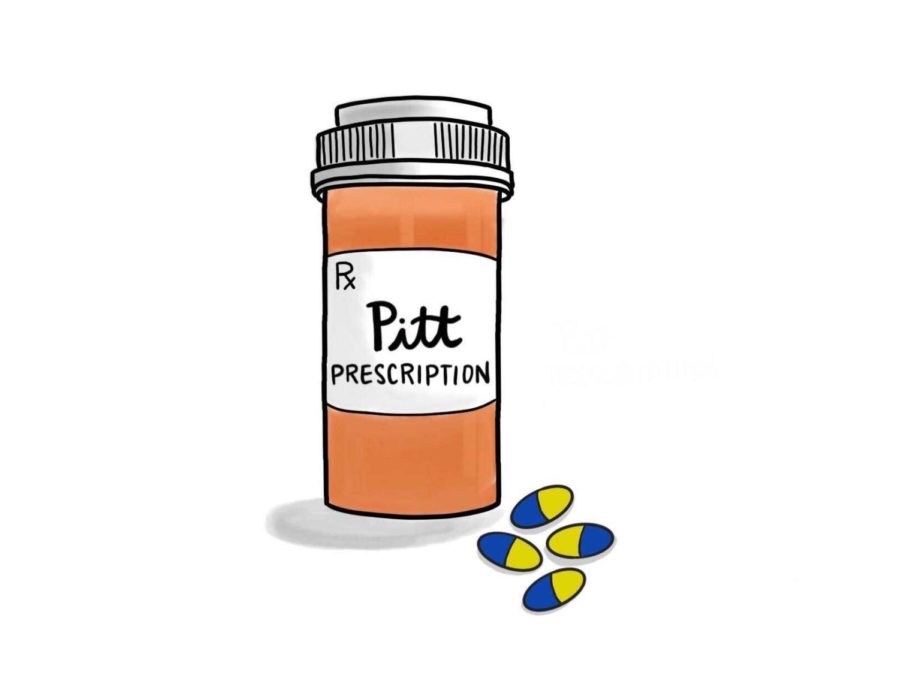The Pitt Prescription | How safe is vaping and why are young adults so drawn to it?
The Pitt Prescription is a biweekly blog where student pharmacist and Senior Staff Writer Elizabeth Donnelly provides tips on how to stay healthy in college. This edition was reviewed by Karen S. Pater, PharmD., CDCES, BCACP.
Shruti Talekar | Contributing Editor
The Pitt Prescription
November 9, 2020
On most college campuses, it would be hard to find a single student who hasn’t seen or at least heard of a Juul, or another type of e-cigarette.
Vaping is the act of inhaling a vapor or aerosol generated by a battery-powered smoking device. These devices, often called vapes, have a cartridge containing a liquid mixture of flavorings, nicotine and other chemical substances, which gets heated up into aerosol for inhalation. Over the past few years, vaping has become increasingly popular among the younger generations, with the National Institutes of Health reporting that in 2018, vaping among high school seniors increased by 9%, from 28% in 2017 to 37% in 2018.
The concerning aspect of this upward trend is that younger generations are beginning to get hooked on nicotine. According to Michael Blaha, M.D., M.P.H., director of clinical research at The Johns Hopkins Ciccarone Center for the Prevention of Cardiovascular Disease, many young people who vape (40%) have never smoked regular tobacco, meaning this is their first exposure to nicotine consumption. But e-cigarettes and vapes are more enticing than traditional cigarettes to adolescents and young adults for several reasons.
First, they tend to be less expensive than regular packs of cigarettes in the long run. They also are a smokeless option, which is appealing to people who dislike the smell and stigma surrounding traditional cigarettes. E-cigarettes also offer many different flavors of cartridges, like mango or watermelon, which entices younger consumers and makes vaping seem less dangerous. Finally, many people believe in the misconception that vaping is much safer than smoking.
While it is true that vaping is less harmful than smoking traditional cigarettes, it is still not a safe practice. It’s likely that e-cigarettes expose consumers to a much smaller number of harmful chemicals than traditional cigarettes, but there are still several problems associated with vaping in general.
As of February 2020, the Centers for Disease Control and Prevention has reported a total of 2,807 hospitalizations due to e-cigarette or vaping product use-associated lung injury (EVALI) spanning across all 50 states, the District of Columbia, Puerto Rico and the U.S. Virgin Islands. There have also been 68 confirmed deaths in 29 states and Washington, D.C., because of EVALI. The majority of EVALI cases are linked with vaping products containing tetrahydrocannabinol — better known by its acronym, THC — though there are several other chemicals in these products that also contribute to the chance for lung injury.
The CDC warns teens and young adults against the use of e-cigarettes because of their nicotine content. The CDC found that 99% of the e-cigarettes sold in the United States contain nicotine, including products that were labelled as zero nicotine. Some brands also do not disclose the nicotine content on their product labels, which can be dangerous.
A report from the U.S. Surgeon General stated that when compared to older adults, adolescents and young adults who use nicotine products are more susceptible to negative consequences of nicotine exposure. These effects include things such as addiction, lowered impulse control, attention and cognition deficits and mood disorders and finally, nicotine being used as a “gateway drug.”
The term “gateway drug” means that the use of one substance helps prime and prepare the consumer to use other, more serious substances in the future, such as marijuana. Additionally, ingestion of e-cigarette liquids with nicotine in them can cause toxicity and potentially death depending on the liquids’ contents. According to the Surgeon General report, several studies have verified the correlation between nicotine use and other substance abuse. Two studies showed a significant correlation between e-cigarette use and the binge drinking of alcohol. It was found that the use of an e-cigarette in the past 30 days had a positive association with current binge drinking and tobacco use.
Not only is nicotine dangerous because it may lead to different substance abuse, but it also may increase the chance of addiction later in life. Using any sort of addictive substance may allow your brain to be more susceptible to forming addictions as you age.
Additionally, nicotine is overall an unhealthy substance for adolescents and young adults to consume because it has the potential to harm the developing brain. The brain continues to develop until about the age of 25 years, but using nicotine can harm the parts of the brain responsible for attention, learning, mood and impulse control. As you learn and create new memories, the brain forms synapses between cells, but nicotine alters the way these synapses are formed and can prevent proper formation in general.
Since e-cigarettes haven’t been around for a long time, there is still so much information that scientists have yet to research. The long-term health effects and the overall toxicity potential of e-cigarette use are still relatively unknown, which is why they are not recommended for young adults or people who have never smoked before. There is strong evidence that the use of e-cigarettes may increase the chance of chronic cough, phlegm, bronchitis and asthma diagnoses. Additionally, e-cigarettes still present the risk for different cancers as well as several cardiovascular issues like an increased risk of blood clots.
With the coronavirus pandemic thrown into the mix, the use of e-cigarettes, vapes or smoking in general is highly discouraged. Stanford researchers found that young adults who vape are at a much higher risk of COVID-19 than their non-vaping counterparts. The study’s senior author, Bonnie Halpern-Felsher, Ph.D., said e-cigarette users are “likely at immediate risk of COVID-19” because they are causing damage to their lungs and COVID-19 is a respiratory illness.
Earlier this year, the Food and Drug Administration released and implemented an enforcement policy that directly prohibited the sale of pre-filled e-cigarette cartridges in any flavor other than menthol or tobacco, unless a seller previously received FDA authorization. This is not a ban on flavored cartridges, but rather stricter regulation of companies. Manufacturers can submit applications to the FDA in order to continue producing and selling flavors other than menthol and tobacco, but they have to prove their safety and consider how their product may affect youth use. This is a vital step taken to lower the number of adolescents and young adults who use these products because they are less inclined to purchase these seemingly unappealing flavors.
The FDA has also worked to prohibit companies from targeting adolescents and young adults with youth-appealing products and marketing. The idea is to try and have these harmful products be less like candy or a treat so that young individuals are not as enticed. Specifically in regards to packaging and marketing, the FDA is requesting that any e-cigarette or vape brands refrain from using kid-friendly images or characters to avoid drawing in young individuals.
Ultimately, there has been a concerning trend seen with regard to teens and young adults using e-cigarettes like Juuls. There are several options to help anyone interested in quitting, and a great resource is your local pharmacy, where the pharmacists are trained to help with smoking/vaping cessation.
Elizabeth writes primarily about self-care and pharmacological topics. You can reach her at [email protected].








